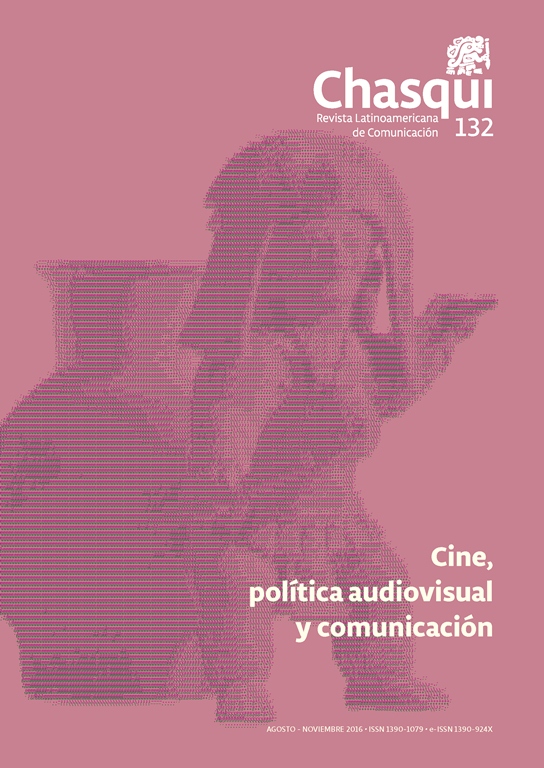Rhetorical construction of corruption
DOI:
https://doi.org/10.16921/chasqui.v0i132.2835Keywords:
corruption, Guatemala, rhetoric, cluster rhetorical analysisAbstract
By embracing a rhetorical approach, this manuscript analyzes how highranking government officials communicate the idea of corruption in relation to the recent scandals of corruption denounced in this country. Rhetorical cluster analysis was used to explore the Guatemalan rhetorical construction of corruption. This analysis led to the identification of three main terministic screens of corruption such as Fraud, Democracy, and Interventionism and showed the use of two rhetorical resources: Accreditation and reference to evidence. It concludes that these clusters and rhetorical devices lead to the normalization of corruption and to the establishment of weak programs of action against this phenomenon.References
Angel, A. & Bates, B. (2014). Terministic screens of corruption: A cluster analysis of Colombian radio conversations. The journal of Kenneth Burke, 10. Retrieved from http://bit.ly/2eR677t.
Aristóteles [Aristotle]. (2001). The Rhetoric. In P. Bizzel, & B. Herzberg (Eds.) The rhetorical tradition: Readings from classical times to the present (pp. 169-242). Boston: Bedford/St. Martin’s.
Baldetti, R. (2015, Mayo 11). Entrevista a Baldetti en Radio Sonora [Video file]. Retrieved from http://bit.ly/2efrkGi.
Bardhan, P. (1997). Corruption and development: A review of issues. Journal of Economic Literature, 35, 1320-1346.
Bates, B. R. (2004). Audiences, metaphors, and the Persian Gulf war. Communication Studies, 55(3), 447-463.
Berthold, C. (1976). Kenneth Burke’s cluster-agon method: Its development and an application. Central States Speech Journal, 27, 302-309.
Bizzell, P. & Herzberg, B. (Eds.) (2001) The rhetorical tradition: Readings from classical times to the present (pp. 283-338). Boston: Bedford/St. Martin’s.
Breit, E. (2010). On the (re)construction of corruption in the media: A critical discursive approach. Journal of Business Ethics, 92, 619-635.
Brummet, B. (1991). Rhetorical dimensions of popular culture. Tuscaloosa: University of Alabama Press.
Burke, K. (1966). Language as symbolic action. California: University of California Press.
Burke, K. (1969). A rhetoric of motives. Berkeley: University of California Press.
Charland, M. (1987). Constitutive rhetoric: The case of the ‘People Québécois.’ Quarterly Journal of Speech, 73, 133-150.
Cicero, M.T. (1942). De Oratore: With English Translation. Cambidge, MA: Harvard University Press.
De los Santos, R. (2015). “The future of our history”: Rhetorics of transformation and power in Plutarco Elías Calles’ 1928 Informe. Rhetoric Society Quarterly. Vol. 45, No. 3, pp. 199–211. Recuperado de http://bit.ly/2eKaJuV.
Cloud, D. (1994). The materiality of discourse as oxymoron. Western Journal of Communication, 58, 141-163.
Fairclough, N. (2008). El análisis crítico del discurso y la mercantilización del discurso público: Las universidades. Discurso & Sociedad, Vol 2(1) 170-185.
Foss, S. (1984). Women priests in the Episcopal Church: A cluster analysis of establishment rhetoric. Religious Communication Today, 7, 1-11.
Gamarra, J. (2006). Pobreza, corrupción y participación política: Una revisión para el caso Colombiano. Bogotá: Banco de la República de Colombia, Documentos de trabajo sobre economía regional. Recuperado de http://bit.ly/2fburnX.
Giglioli, P. (1996). Political corruption and media: The Tangentopoli affair. International Social Science Journal, 48, 381-394.
Lynch, J. (2006). Race and radical renamings: Using cluster agon method to assess the radical potential of “European American” as a substitute for “White.” K. B. Journal, 2. Retreived from http://www.kbjournal.org/lynch.
Montilla, G.R., & Jackman, R.W. (2002). Sources of corruption: A cross-country study. British Journal of Political Science, 32, 147-170.
Mosca, L.D. & Pistori, M.H.C. (2016). Estudos de retórica e argumentacao: A maioridade do gerar. Trabalhos Completos ALED. Puebla,1(1).
Multivex Sigma Dos Guatemala (2015). Medición de diciembre radio. Retreived from http://bit.ly/2dPSBOK.
Pardo, N. (2011). Violencia simbólica, discursos mediáticos y reproducción de exclusiones sociales. Discurso & Sociedad, 7(2), 416-440.
Pérez, O. (2015, Agosto 27). Otto Pérez Molina dice “No renuncio”. [Video file]. Retrieved from http://bit.ly/2e1lryU.
Platón [Plato] (2001). Phaedrus. In P. Bizzel, & B. Herzberg (Eds.), The rhetorical tradition: Readings from classical times to the present (pp. 138-168). Boston: Bedford/St. Martin’s.
Potter, J. (1996). Representing reality: Discourse, rhetoric and social construction. London: Sage.
Quintiliano [Quintilian] ([1856] 2006). Institutes of oratory. L. Honeycutt, Ed., (J.S. Watson, Trans.). Retrieved from http://rhetoric.eserver.org/quintilian/.
Restrepo, J.D. (2005). El escándalo: Una construcción social y política de la corrupción en los medios de comunicación. Escribanía, 15, 69-77.
Ruhl, J.M. (2011). Political corruption in Central America: Assessment and explanation. Latin American Politics & Society, 53(1), 33-58. doi:10.1111/j.1548-2456.2011.00108.x
Solimano, A., Tanzi, V. & del Solar, F. (2008). Las termitas del Estado: Ensayos sobre corrupción, transparencia y desarrollo. Santiago de Chile: Fondo de Cultura Económica.
Torres, E. (2015). Guatemala: La corrupción como crisis. Nueva Sociedad, 257, 4-15.
Ureña, N.E. (1997). Corrupción y ética: Polos opuestos de la misma realidad. En F. Cepeda (Ed.), La corrupción en Colombia (pp. 211-231). Bogotá: Tercer Mundo Editores.
Vargas-Hernández, J. (2009). The multiple faces of corruption: Typology, forms and levels. Contemporary Legal & Economic Issues, 3, 269-290.
Downloads
Published
Issue
Section
License
- Authors retain copyright and grant the journal right of first publication with the work simultaneously licensed under a Creative Commons Attribution-NoDerivs License (CC BY-ND) that allows others to share the work with an acknowledgement of the work's authorship and initial publication in this journal.
- Authors are able to enter into separate, additional contractual arrangements for the non-exclusive distribution of the journal's published version of the work (e.g., post it to an institutional repository or publish it in a book), with an acknowledgement of its initial publication in this journal.
- Authors are permitted and encouraged to post their work online.

